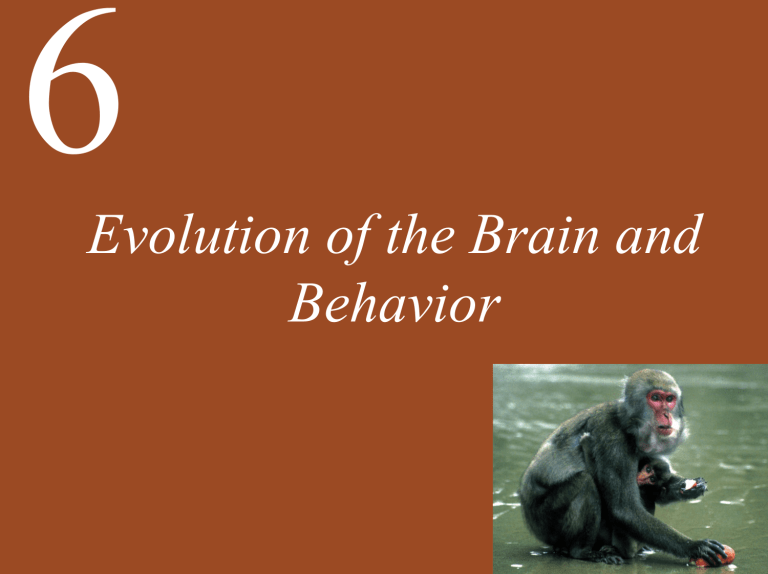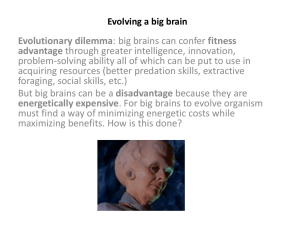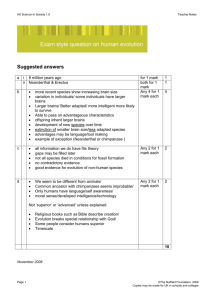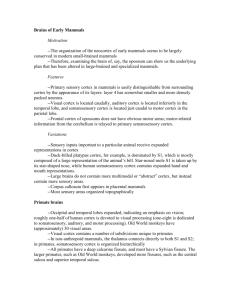
6 Evolution of the Brain and Behavior 6 Evolution of the Brain and Behavior •How Did the Enormous Variety of Species Arise on Earth? •Why Should We Study Other Species? •All Vertebrate Brains Share the Same Basic Structures 6 Evolution of the Brain and Behavior •The Evolution of Vertebrate Brains Reflects Changes in Behavior •Many Factors Led to the Rapid Evolution of a Large Cortex in Primates Loading… •Evolution Continues Today 6 How Did the Enormous Variety of Species Arise on Earth? Until about 200 years ago, it was believed that species were created separately. Naturalists, students of animal life and structure, began to doubt this. Fossils of extinct species provided evidence for evolution—the gradual change of a species. Figure 6.1 Homology of Forelimb Structures Loading… Figure 6.2 Natural Selection at the Genetic Level Figure 6.3 Linnaean Classification of the Domestic Dog Figure 6.4 Family Tree of Apes and Humans Figure 6.5 We Are Related, Aren’t We? 6 Why Should We Study Other Species? Selection for increased size of the forebrain correlates positively with the ability to cope with environmental challenges and opportunities in new, flexible ways. 6 Why Should We Study Other Species? Differences in brain size and structure can be due to behavioral adaptations. Novel or strategic food-seeking behavior is correlated with larger brain size. Loading… Figure 6.6 Food Storing in Birds as Related to Hippocampal Size 6 Why Should We Study Other Species? Animals who depend on hearing, vision, or memory for their food develop larger related brain structures. In some species of songbirds, song repertoires are adaptive behaviors. There is a strong correlation between repertoire size and HVC. Figure 6.7 Brainy Warblers Sing More Songs Box 6.2 To Each its Own Sensory World Mammals’ lifestyles are related to cortical organization: • Nocturnal rodents (like rats) that use whiskers have a large part of their cortex devoted to their whiskers but much less to vision compared to diurnal rodents (like squirrels). • The platypus uses its bill to detect mechanical and electrical stimuli; most of its somatosensory cortex is devoted to the bill. Box 6.2 To Each Its Own Sensory World 6 Why Should We Study Other Species? Nervous systems vary widely in structure and complexity. Structures range from nerve nets, radial nerves, neural rings, and simple ganglia in invertebrates to central and peripheral nervous systems in vertebrates. Figure 6.8 A Comparative View of Nervous Systems Figure 6.9 Functions and Relations 6 All Vertebrate Brains Share the Same Basic Structures Each of the main structures in the human brain has a counterpart in the rat brain. Differences between human and rat brains are in actual and relative size of regions, such as cerebral cortex and olfactory bulbs. Figure 6.10 Human and Rat Brains Compared 6 All Vertebrate Brains Share the Same Basic Structures Vertebrate nervous systems share certain main features: • Develop from a hollow dorsal neural tube • Bilateral symmetry • Segmentation • Hierarchical control • Separate peripheral and central nervous systems • Localization of function Figure 6.11 The Same Kind of Neuron in Different Species 6 The Evolution of Vertebrate Brains Reflects Changes in Behavior Two methods are used to study evolution of the brain: 1. Endocast—uses fossil skulls to make a cast of the brain to give a reasonable indication of the size and shape of the brain, but no fine detail. Figure 6.12 Brain Regions in Seven Classes of Vertebrates 6 The Evolution of Vertebrate Brains Reflects Changes in Behavior We must be careful not to interpret change over time, including the change in brain size, as if it were a linear evolutionary sequence. The main classes of vertebrates represent different lines or radiations of evolution that have been proceeding separately and simultaneously for at least 200 million years. 6 The Evolution of Vertebrate Brains Reflects Changes in Behavior The differences are not in the basic subdivisions but in their relative size and elaboration. All mammals have a six-layered cortex, also called neocortex. • Reptiles were the first vertebrates to have a cerebral cortex, but they have only three cortical layers, unlike the six cortical layers of mammals. 6 The Evolution of Vertebrate Brains Reflects Changes in Behavior The encephalization factor is a measure of brain size relative to body size. The relationship between brain weight and body weight is similar for all classes of vertebrates. Brain weight relative to body size does vary between and within classes. Figure 6.13 The Relation between Brain Weight and Body Weight Loading… Figure 6.14 Who Is the Brainiest? Figure 6.15 Was the Dinosaur Being Too Modest? Figure 6.16 Changes in the Apportionment of Brain Regions among Primates 6 The Evolution of Vertebrate Brains Reflects Changes in Behavior In primates, brain regions that develop later have enlarged more than earlier regions. Larger brains have evolved by prolonging the later stages of development. In humans, this may explain changes in the cortex, where new neurons form the outermost layers. Figure 6.17 Evolution Allows Later-Developing Brain Regions to Grow Larger Figure 6.18 Hominid Evolution 6 Many Factors Led to the Rapid Evolution of a Large Cortex in Primates As Homo erectus evolved, brains became larger and faces got smaller than the australopithecines. Homo erectus made elaborate tools, used fire, and hunted. They also expanded their area over three continents. With Homo sapiens, brain volume evolved rapidly and had reached modern levels about 150,000 years ago. 6 Many Factors Led to the Rapid Evolution of a Large Cortex in Primates A large brain has costs and benefits: •A long gestation period •Prolonged dependence on parents •High metabolic cost •Complex genes vulnerable to mutation 6 Many Factors Led to the Rapid Evolution of a Large Cortex in Primates The social brain hypothesis suggests a larger brain is needed to maintain social relationships between similar individuals. Primates show a correlation between clique (a group of individuals that regularly socialize with one another) size and size of the cortex relative to overall brain size. Figure 6.19 The Social Brain Hypothesis 6 Many Factors Led to the Rapid Evolution of a Large Cortex in Primates Adaptive advantages of a large brain include: •Increased survival and ability for group interaction in humans •Innovative behavior, use of tools, and social learning in all primates Figure 6.20 Transmitting Culture 6 Many Factors Led to the Rapid Evolution of a Large Cortex in Primates Large brain size can also predict success in a novel environment, such as in introduced bird species. • A study examined more than 600 examples of introduction involving 195 bird species found that the species with larger brains, relative to body size, tended to be more successful in establishing themselves in novel environments. 6 Many Factors Led to the Rapid Evolution of a Large Cortex in Primates Sexual selection pressures for ability to attract attention, artistry, and creativity may lead to increased brain size, as in bowerbirds. Figure 6.21 A Bowerbird Nest 6 Many Factors Led to the Rapid Evolution of a Large Cortex in Primates Very similar genomes can produce different brains: •A few crucial genes can have a great effect on development. •Small changes in DNA can alter the timing and location of gene expression. Figure 6.22 Differences in Gene Expression in Various Tissues Reveal the Extent of Similarity between Species Figure 6.23 Over Your Head 6 Evolution Continues Today Some evolution can be rapid: • Overuse of antibiotics speeds evolution of resistant bacteria. • Bighorn rams with smaller horns are not hunted, thereby surviving longer. • Darwin’s finches continue to change in response to food supply. • The largest cod are kept, and remaining ones mature at smaller sizes. 6 Evolution Continues Today Radiocarbon dating shows the colonization of Europe and Asia by Homo sapiens 50,000 years ago. Differences in skin color, facial features, and stature of inhabitants of those regions have occurred since then, in response to climate conditions. Figure 6.25 The Colonization of Europe and Asia by Homo sapiens 6 The Cutting Edge: Are Humans Still Evolving? Minor variations where one nucleotide substitutes for another can occur at certain locations within a gene (or neighboring stretch of DNA); these are called singlenucleotide polymorphisms (SNPs; polymorphism means “many shapes”). • Most SNPs (not all) have just two different versions, or alleles. Figure 6.26 SNP Variation and Natural Selection (Part 1) 6 The Cutting Edge: Are Humans Still Evolving? In the absence of selection pressure, DNA from different individuals shows a random mix of SNP alleles in the gene and surrounding DNA. But recent active selection pressure that favors a specific allele within the gene results in the SNPs in the gene and its surrounding regions being invariant because they have recently spread from an originating individual. Figure 6.26 SNP Variation and Natural Selection (Part 2) 6 The Cutting Edge: Are Humans Still Evolving? Genes that have been subject to recent natural selection show reduced variation in adjacent SNPs. Table 6.1 Examples of Human Genes Subject to Recent Selection Pressure 6 The Cutting Edge: Are Humans Still Evolving? Not all changes in recent humans are evolutionary, or even genetic. The increased stature of modern humans, for example, has more to do with good nutrition and medical advances than changes in any genes —another form of cultural evolution. 6 The Cutting Edge: Are Humans Still Evolving? Some responses to environmental pressures involve epigenetic modifications of gene expression. For example, early stress produces lasting changes in the expression of genes encoding stress hormone receptors. As long as we all don’t make equal contributions to next generations, evolution is still occurring in humans.






